Japanese beetles begin to emerge in early summer. That's the time to get control measures going. These pests live most of their lives as grubs in the soil, then emerge as adults in summer and decimate trees, shrubs, and flowers.
What makes them hard to stop is 1) their sheer numbers, and 2) they often fly long distances from place to place looking for food (and mates).
Spraying them will stop them for a few days until more fly in from elsewhere. So how do we stop these hungry nanobots of destruction, or at least slow them down and protect our plants? Well, let’s start with what Japanese beetles love – and what they hate.
Jump to:
- What Do Japanese Beetles Love?
- What Do Japanese Beetles Hate?
- Japanese Beetles Also Hate …
- Encourage Insect and Bird Assassins
- Diatomaceous Earth
- Hand Collecting Beetles
- Shaking the Tree
- Trapping
- Emptying the Traps
- Chickens For the Win!
- Vacuuming
- Floating Row Covers
- Entomophagy
- Essential Oils
- What About Companion Planting?
What Do Japanese Beetles Love?
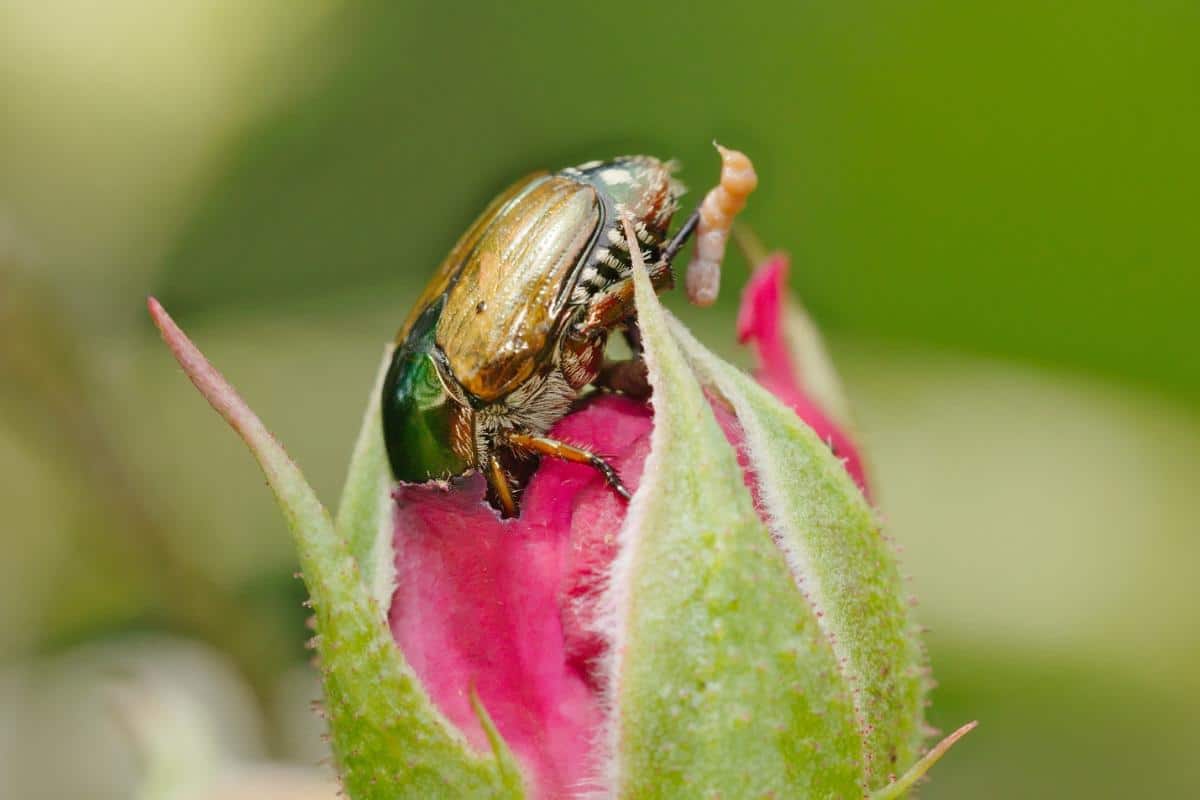
Heat. They fly and move faster when it’s nice and hot outdoors.
Direct sun. Japanese beetles prefer to eat in the sun. When you pick them off the plants, most of them will be in the sun. If you have a valuable potted plant, put it in a shady area so they won’t attack it as much.
Grass lands and lawns. Grubs eat grass roots to grow, so females lay eggs in lawns (especially those with short grass). Let your grass grow a little taller to discourage them. Better yet, start converting your lawn into a garden.
Water. Japanese beetle eggs need water to expand. When adult beetles emerge, stop watering your lawn as much as possible to weaken the eggs they lay.
Juicy flowers, fruit, and leaves. They’ll eat the heck out of your roses and fruit. Give your plants less nitrogen to make them less inviting to beetles.
Mating. This is pretty self-explanatory to anybody who has seen a group of Japanese beetles. Spray them with soapy water or neem oil before they lay eggs in your yard!
What Do Japanese Beetles Hate?
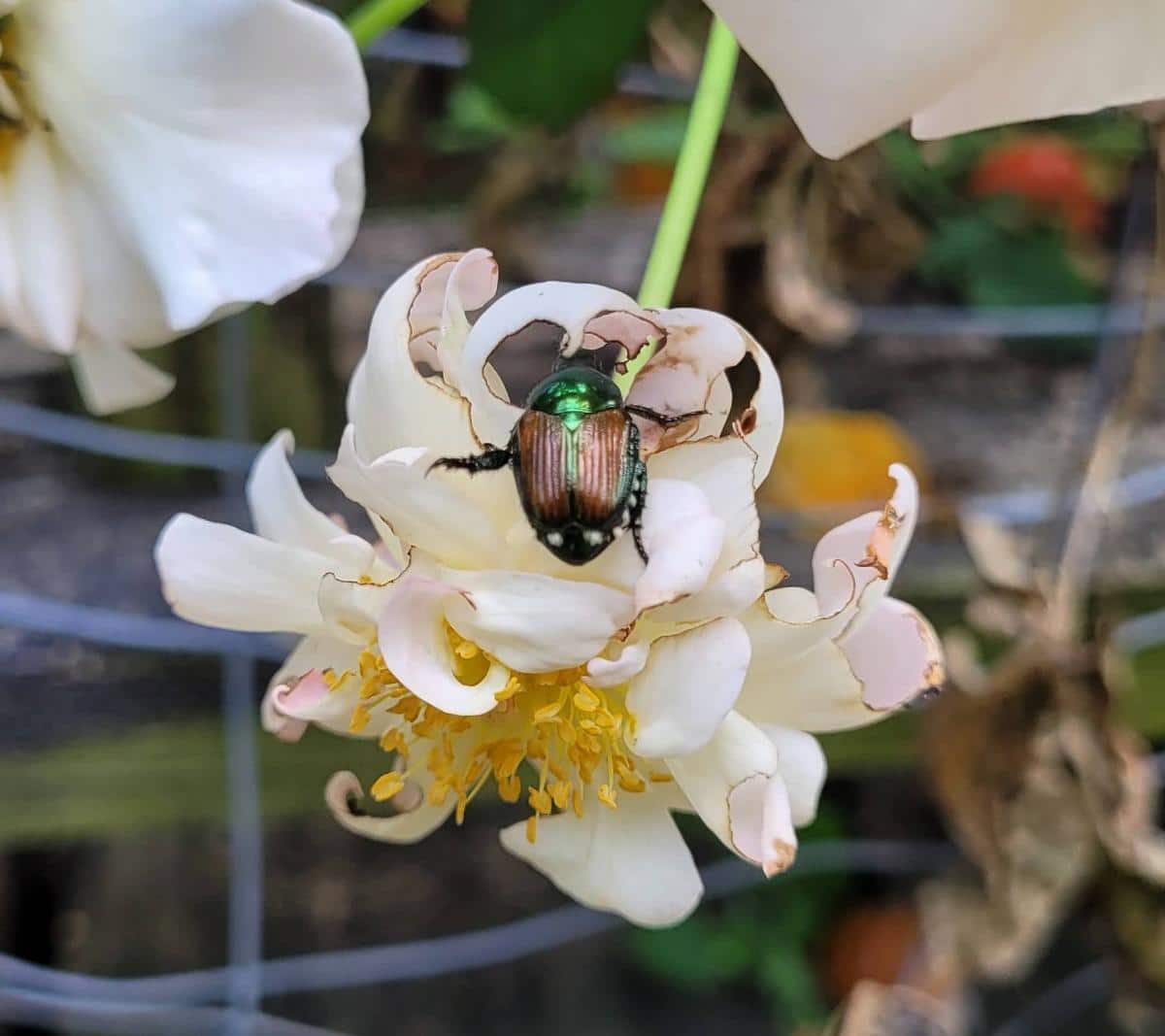
Cold. Even on cool summer mornings, they are sluggish and slow. Take advantage of this by laying a sheet or tarp under an infested tree and shake it. They’ll fall to the ground and lie there, and you can dispose of them.
Shade. For some reason they prefer to stay in the sun, even on ultra hot days, and avoid the shade. If a beloved plant is being swarmed by Japanese beetles, see if it helps to put the plant into the shade.
Forests. There’s too much shade in the forest and no grass for them to lay eggs under. If these beetles are the bane of your life, create a grassless area under your trees and make a shade garden.
Barriers. Anything that keeps them from their food – floating row covers, kaolinite sprayed on the leaves.
Water (again). An especially wet spring will drown, developing grubs and pupae in the grass.
Japanese Beetles Also Hate …
… these tips I’m about to share with you. Read on.
Encourage Insect and Bird Assassins
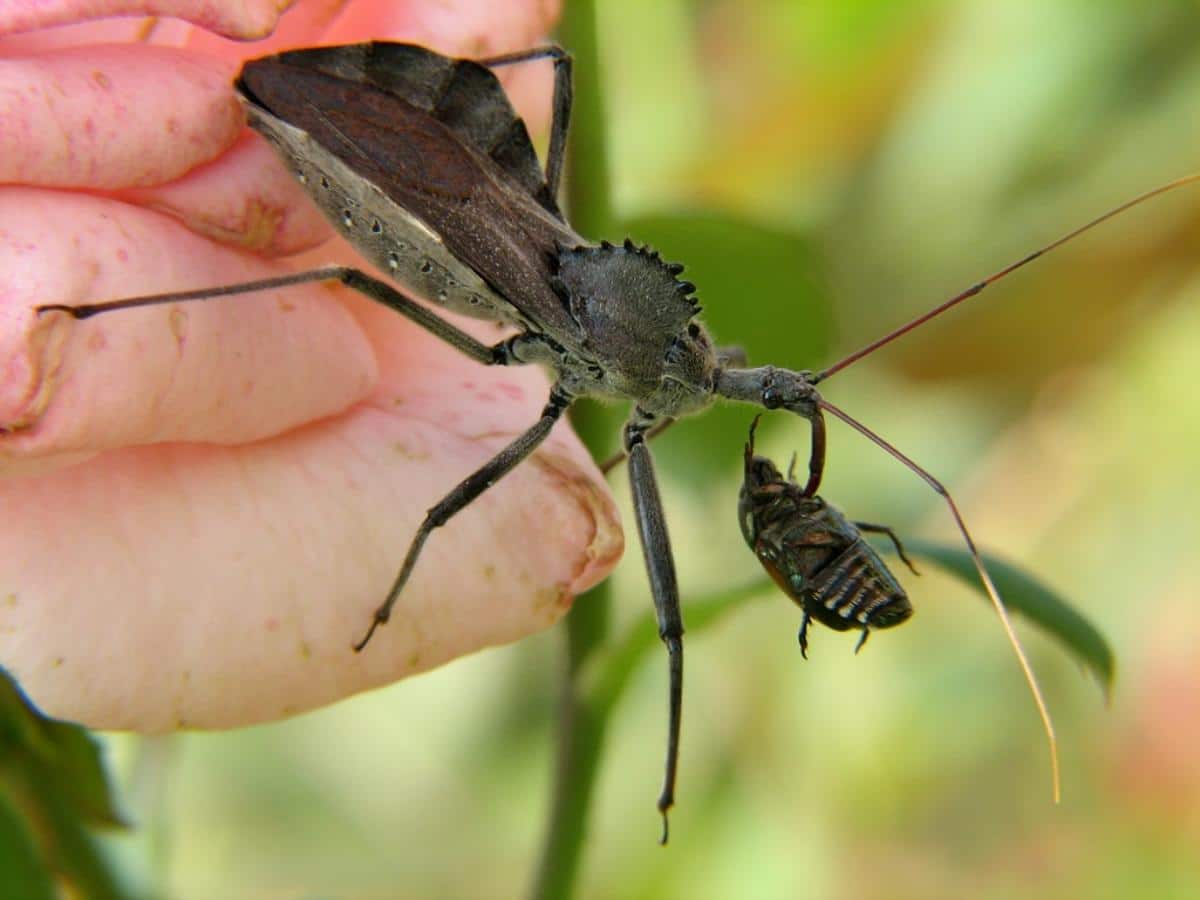
Japanese beetles do have natural enemies, though at this time not enough to cut down their numbers. Every little bit helps, though.
Wheelbugs and assassin bugs are two insects I won’t pick up because they carry tiny knives and will stab you. However, they also will stab Japanese beetles and then drink the juice out of them.
Some birds also eat Japanese beetles. Starlings and grackles will walk through the grass, picking grubs out of the soil. Cardinals and catbirds
Invite predatory insects and birds to your yard. Give birds water, fruit-bearing shrubs, and safe trees to hide from predators. Go organic with your garden so predatory insects can live and multiply.
Read more:
- 10 Most Common Garden Pests and How to Fight Them
- 15 Tips to Use Organic Pesticides Safely
- 16 Ways to Attract Bluebirds for Garden Pest Control
Diatomaceous Earth
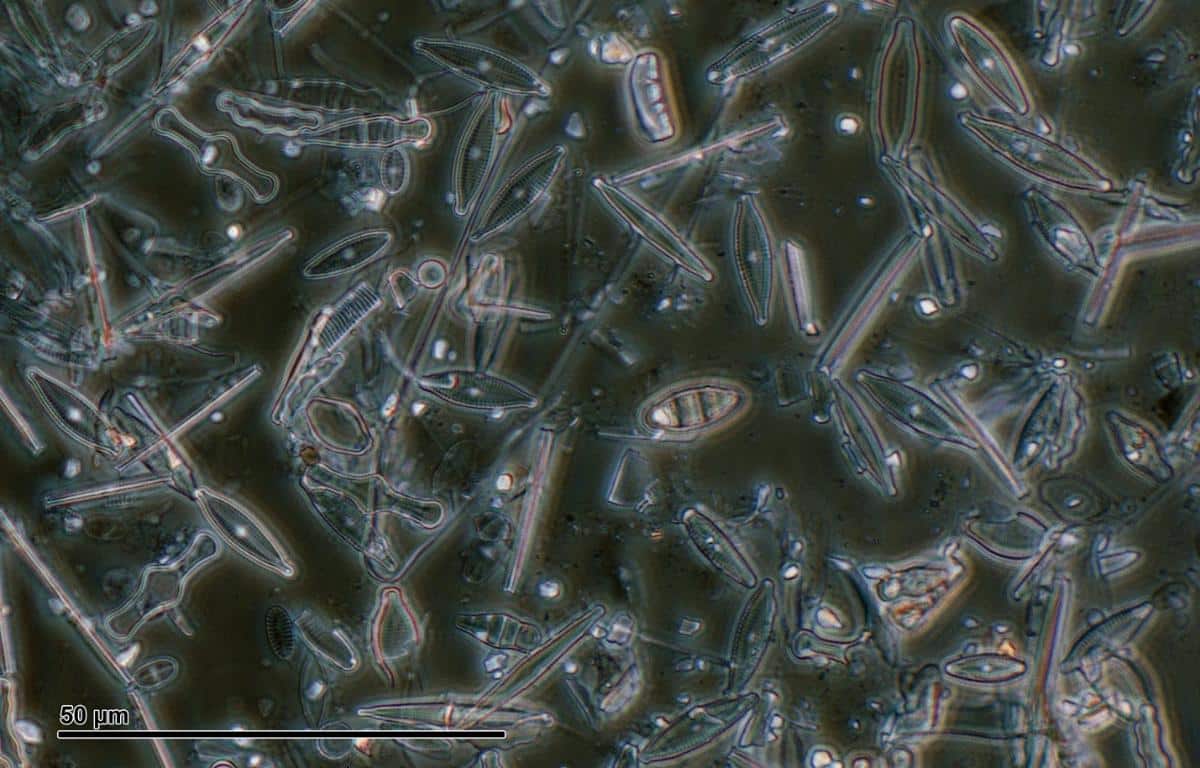
You’ve probably read in school that chalk is made up of tiny microscopic things called diatoms. These are the dried, sharp-edged shells of single-celled algae made of silicon dioxide.
Diatomaceous earth, or DE, is a fine white dust that is made up of diatoms.
How does DE work? Well, insect exoskeletons are covered with a type of wax called chitin. This wax protects the insects and keeps their interior moisture inside. The microscopically sharp edges of the diatoms in DE cut into the exoskeleton and absorb the water-protecting oils and fats from the exoskeleton’s outer layer. Result? The insect dries out and croaks.
It seems strange that microscopic shells would be able to kill insects. But it works. When my daughter was little, she’d draw pictures on the sidewalk with chalk. The next morning, I’d go outside and see the remains of a slug or two that had scrawled onto the chalk lines. It looked like they’d exploded. This will definitely ruin your breakfast.
DE won’t cause instant knock-down of your beetles, but the beetles (and other insects) that come in contact with this dust will dry out and die.
If you dust your plant’s leaves with DE, wear a dust mask and eye protection. The dust is not only abrasive to insects but also to your lungs and eyes.
If it rains, you have to reapply it, as DE loses its effectiveness when wet.
Note: Don’t use DE when pollinators are visiting the area around your tree, especially honeybees. It will kill them as well.
Hand Collecting Beetles
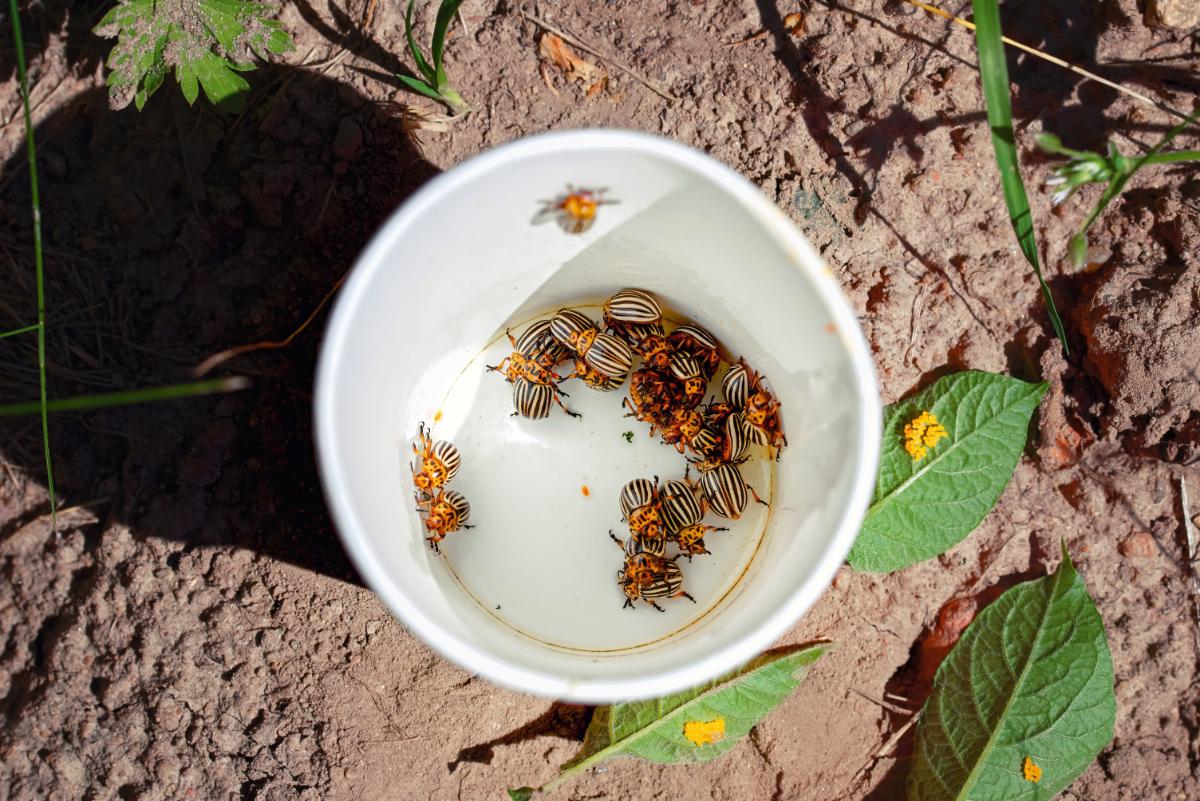
Hand collection is the organic way to kill beetles. It’s straightforward – knock the beetles of the plant into a cup of soapy water with a little bit of rubbing alcohol. (We used rubbing alcohol in entomology class to kill bugs for our collections, and it’s very effective.)
If you’re collecting beetles for chicken feed, use plain water.
Move fast when collecting beetles by hand. When disturbed, the beetles fold their legs and drop to the ground before you can grab them or fly away.
I noticed that when I went around the yard every evening cleaning up beetles, soon I didn’t see as many in the yard over the next few days. Fewer beetles in the yard mean that there were fewer beetle pheromones attracting other beetles. So even cutting the numbers of beetles means having fewer incoming beetles, and less damage. Every little bit helps.
Shaking the Tree
Do this in the morning before the sun comes up when it’s still cool outside. Lay a couple of sheets or tarps flat on the ground under a tree, then shake the tree hard so the beetles fall out onto the sheets. The beetles will be too cold to fly off, and they’ll just lie there, helpless. When it’s dark and cool, Japanese beetles are sitting ducks. Spray them with soapy water with a little rubbing alcohol added to kill them and shake the tree again. Keep repeating until you’ve killed what beetles you can, then roll up the sheet and dispose of the bodies.
If you have a lot of beetles, dump their remains in your compost pile and cover them up. This will keep the dead beetles from smelling up the place, and then you get compost. It’s a beetle burial with benefits.
Trapping
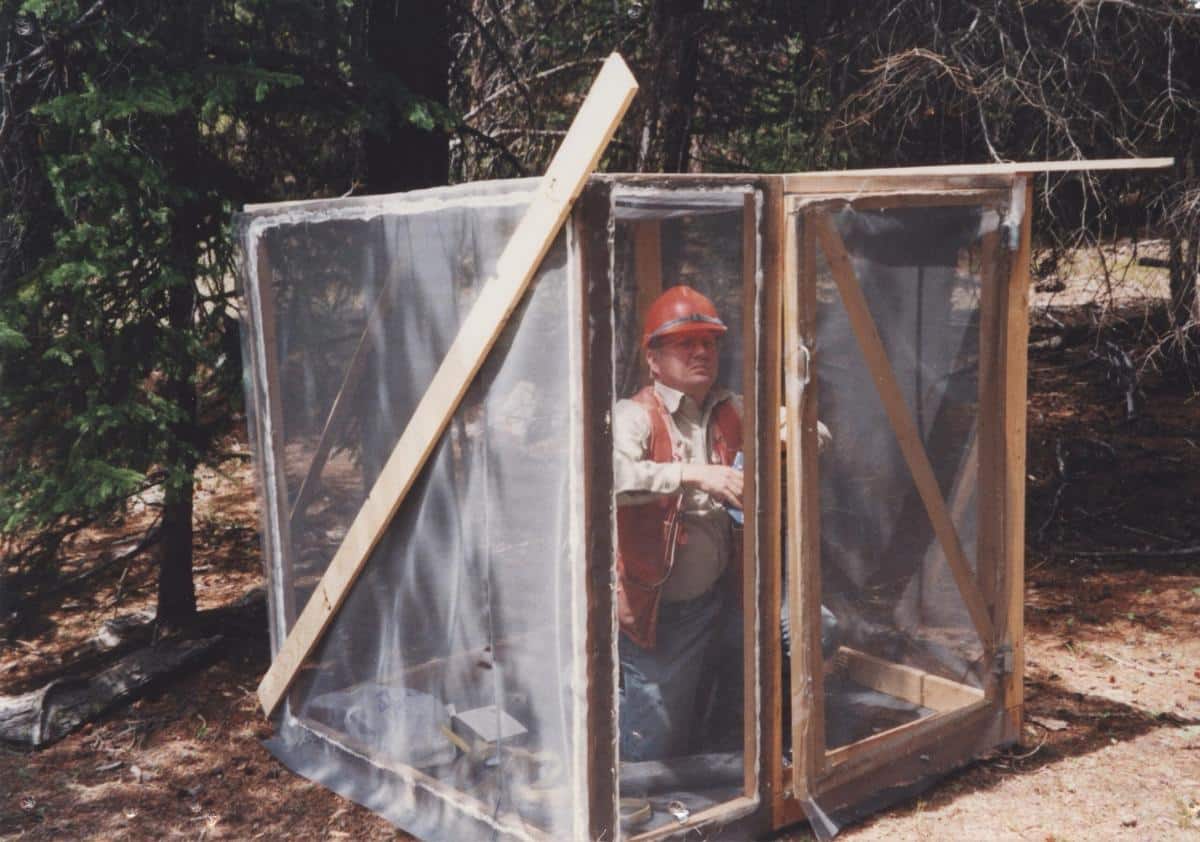
The traps sold for beetle (adult) control use either a female sex pheromone (a “come hither” pheromone) or a “floral-base lure” (that is, some of the floral-based or a food-based chemical smell) to lure beetles. However, a lot of beetles come into the area, lured by the smell, but then end up on a nearby plant instead, chewing it to shreds.
These traps really attract a lot of beetles. In open fields and wide yards, air currents can travel freely and bring beetles in from 500 yards away.
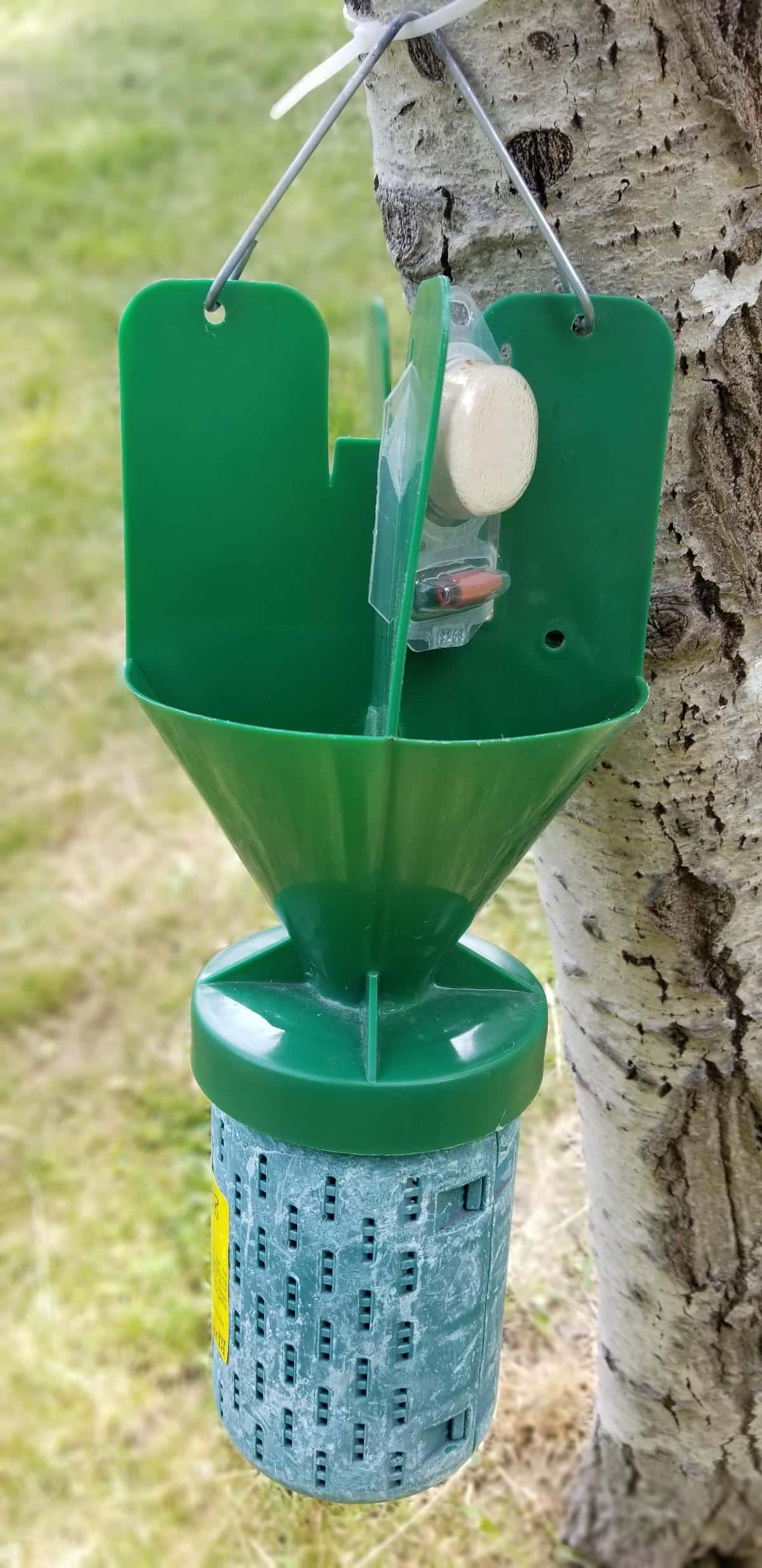
Many beetles do not actually get into the bag. Instead, they fly around the bag in huge numbers, and there’s this serious 1960s love fest happening all around it.
One way to deal with this is to spray around the bag with organic insecticide. This will knock the flying beetles out of the air … into oblivion.
These traps do help if the infestation is light. They also capture females before they’re finished laying eggs, which helps to keep local infestations at a minimum.
When placed near houses surrounded with trees, these traps will draw beetles only from the immediate surroundings. The trees and shrubs slow the air currents and the pheromone stays mostly in your yard. So place your traps where they’re out of the wind.
The best use for traps would be in a large, cooperative campaign over a large area. If a single city pushed for residents to put up beetle traps all through the city, they’d see a far more effective knockdown of the local beetle population. Placing traps every 200 feet in town will reduce local beetle numbers.
Emptying the Traps
There’s another problem with traps – each trap holds about 4,000 beetles. You’re going to get way, way, WAY more Japanese beetles than that.
Every day, dump the bags into a bucket of soapy water to drown the beetles. Then you can use the bags again. Use a pair of disposable gloves to dump the bags because these bugs stink like death, and the smell will stick to your good gloves.
Dump the dead beetles into the compost pile and cover them up. Or dig a hole in the ground and keep adding to it.
Chickens For the Win!

I actually look forward to Japanese beetle season in one respect: It’s free chicken food. Every year, I hang a Japanese beetle trap low in the chicken pen with the bottom of the bag cut off and hanging right over a water dish. The beetles fall into the bag and into the water, and the chickens snap them up. Chickens will jump into the air to catch flying beetles, or chase them around the chicky yard. It’s great fun.
When I go around the yard hand-picking beetles into a cup of water, I’ll let the chickens out. The girls will follow me everywhere because they want all the beetles.
Vacuuming
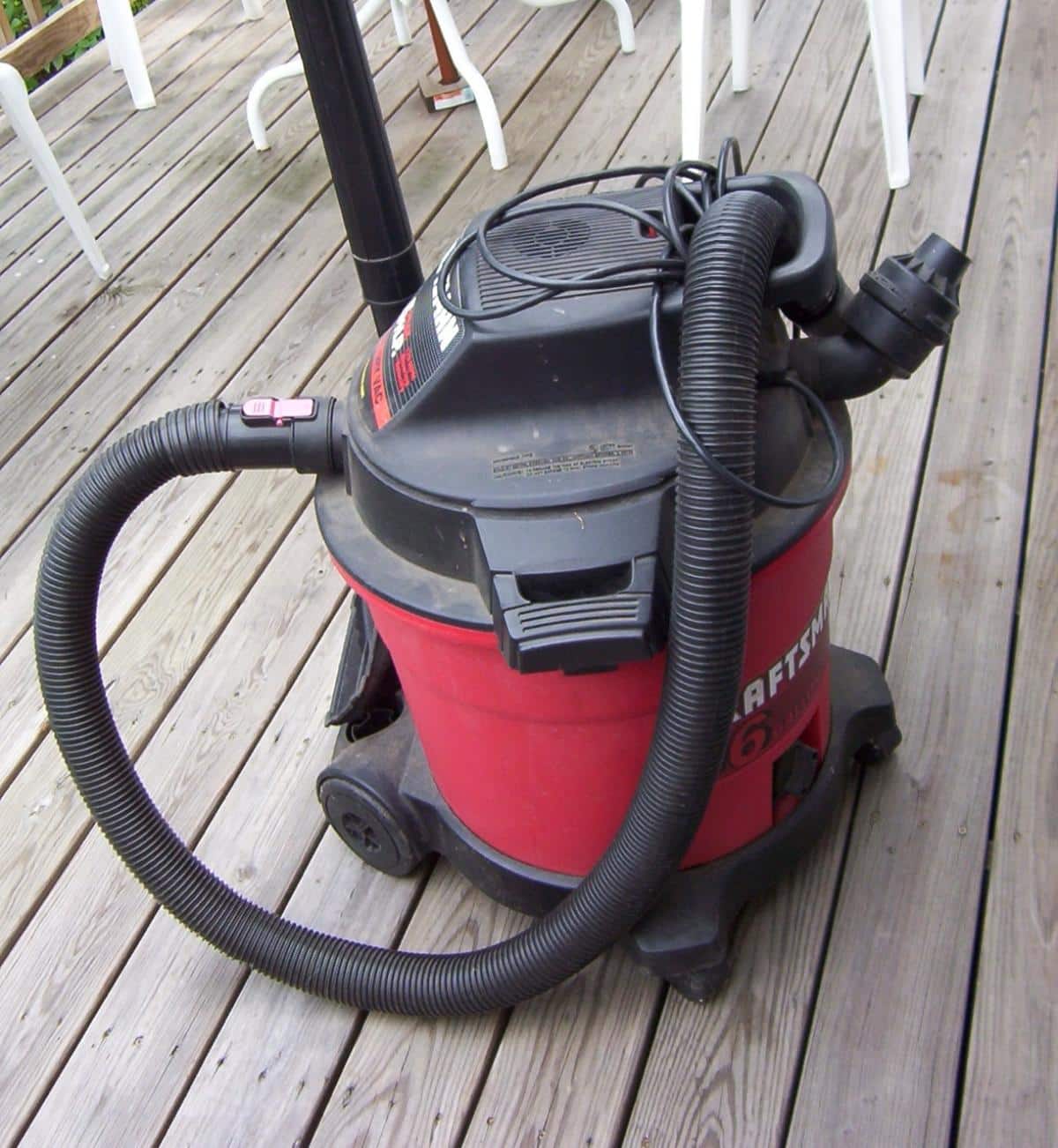
If you have lots of beetles on a plant and you’re very frustrated, vacuum them up in your Shop-Vac! Plug a wet/dry vacuum into a grounded outlet, take out the filter bag, and pour in several glugs of rubbing alcohol before shutting the lid. Rubbing alcohol fumes will kill the beetles that get vacuumed up.
Then drag that thing outside and start vacuuming the beetles off the leaves of your plants. Experiment with nozzle sizes to find the one that works best. Hold the nozzle away from the leaves so you suck up beetles and not the entire plant.
When you’ve vacuumed enough, shut it off and let the alcohol fumes knock down the beetles for about 5 minutes. Then, open the Shop-Vac and dump the bodies into a shallow grave.
Read more:
- 6 Beneficial Insects in the Rose Garden (and How to Attract Them)
- How to Use a Handheld Vacuum to Control Garden Insects (Video)
- 8 Ways to Control Leaf-Footed Bugs Organically + Insect and Damage ID
Floating Row Covers
Floating row covers are specially designed fabrics that are laid over plants to protect them against frost. These also keep insects and other pests out of your plants, including Japanese beetles.
Before the beetles show up, cover prized plants with floating row covers. Choose a light material that lets light in but doesn’t trap much heat. Peg the edges of the cloth down securely so beetles can’t wriggle their way in. A bunch of little frustrated beetles will try to chew their way through. Spray them with neem oil or some other organic insecticide while they’re sitting ducks.
Entomophagy

Entomophagy simply means “eating insects.”
If your initial reaction to this is ICK ICK ICK ICK, just skip to the next section, which involve essential oils and might be a little better for your nerves than this topic.
Japanese beetles are actually good sources of food. Both beetles and grubs are edible, and up to 40 percent of their body weight is made up of protein.
To collect them, cut off the top of a 2-liter pop bottle, then take the cut-off part and invert it onto the base for an instant funnel. Then knock the beetles into this funnel.
Kill the beetles by freezing them for about 10 to 15 minutes. If you have only a few beetles, just leave them in the freezer until you get enough to cook up.
Some people simply fry the beetles in oil in a wok or a frying pan. Others boil the beetles for 15 minutes, then marinate them in a favorite sauce overnight (such as cranberry marinade). Then put them in the dehydrator and dry them to a crispy crunch.
It might take a little work to get past the ick factor, but hey, in a world where people eat haggis and deep-fried sticks of butter, I think we can also eat the apple-flavored bugs that have entirely devoured our apple trees in the backyard. And this form of revenge is … particularly apt.
Essential Oils
Field studies done with 41 different essential oils concluded that wintergreen oil and peppermint oil were the two most effective oils at repelling Japanese beetles. These oils were followed by anise, bergamont mint, cedarleaf, dalmation sage, tarragon, and wormwood oil.
Combining wintergreen oil with ginger, peppermint, or citronella oils also worked to mask the scent of desirable plants so the beetles couldn’t smell them. Cedar oil spray, if you can find it, is a good choice as well.
These oils will need to be re-applied after every rain, and will also need to be sprayed about twice a week for the best benefit.
Essential oils are natural and also have the benefit of smelling good when you spray them. Think of it as aromatherapy for a beetle-stressed gardener.
What About Companion Planting?
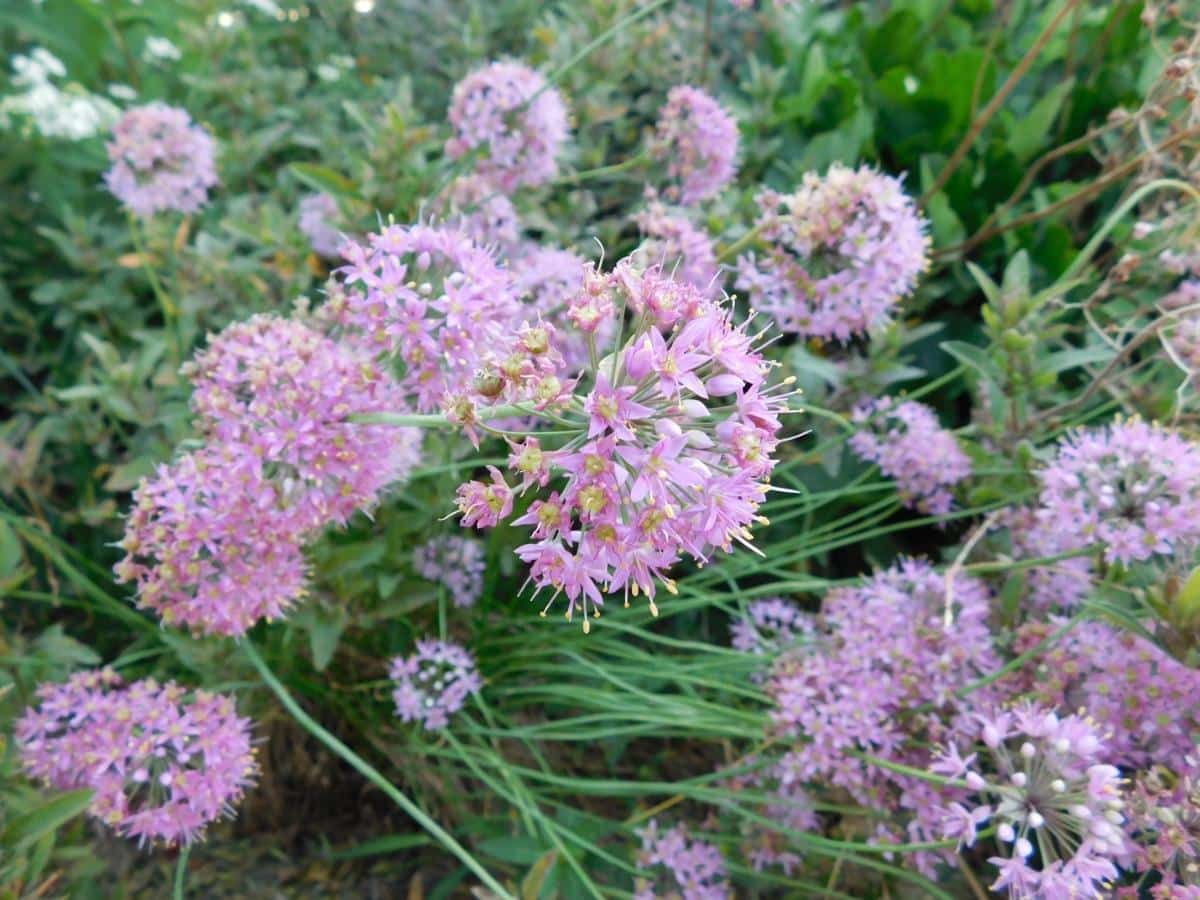
It doesn’t work. Yes, a lot of websites say otherwise. “Plant tansy, four o’clocks, geraniums, catmint, and chives. These plants will keep them away and kill them if they eat them.” Sounds good in theory, but Japanese beetles will roll in and eat whatever they want.

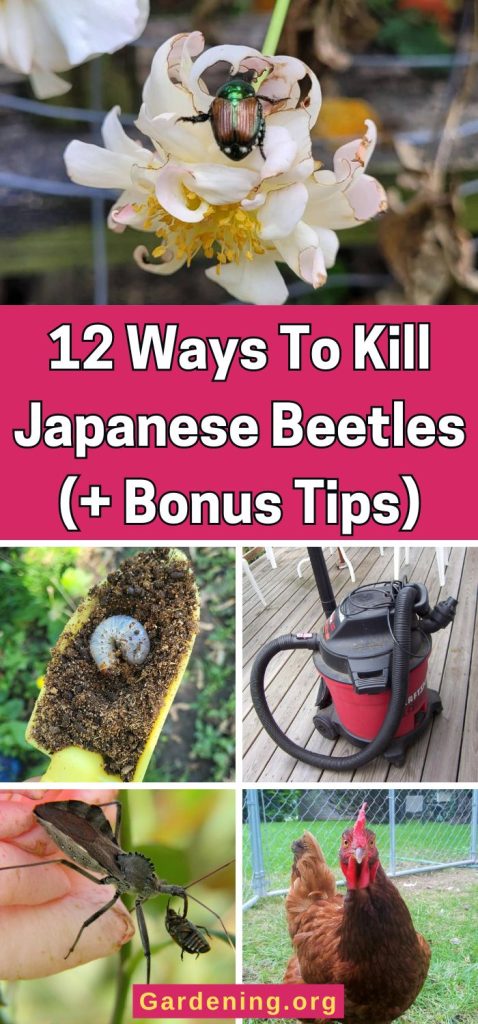
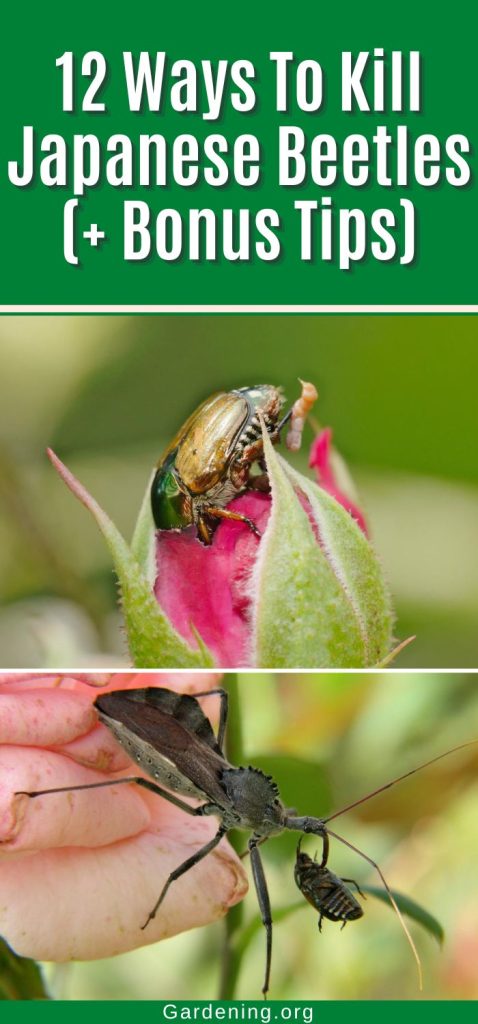
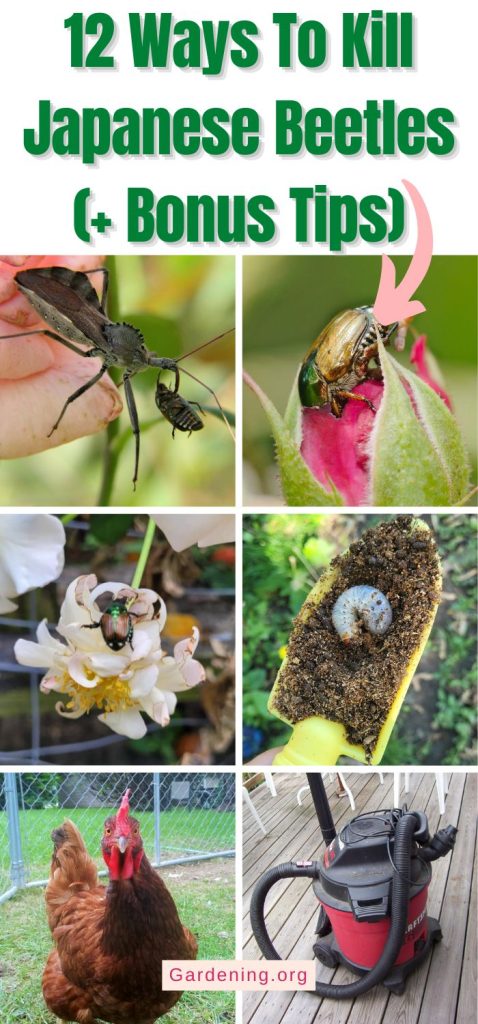
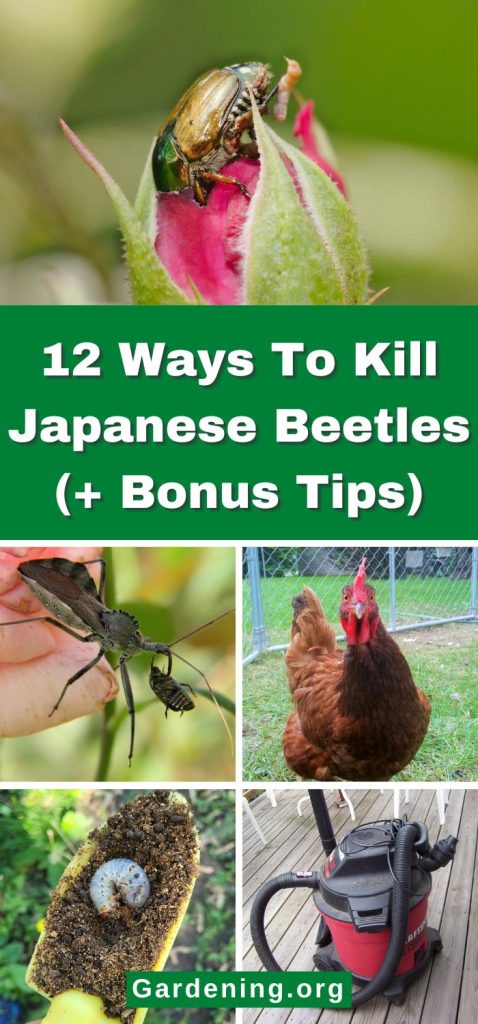



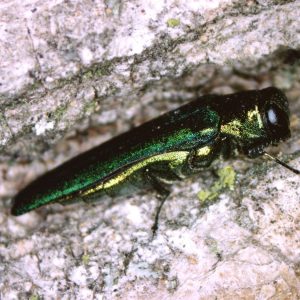
Ellyn
I have used traps---not helpful as too many are attracted--once I collected 40 pounds of the bugs. I now use Beatle Be Gone and it works to kill bugs AND the adult beetles--add a sticker spreader as well. I use on my large rose bed. They do come and take a bite or two and then bingo they are dead. This product can be used on fruit like raspberries as well and is used by organic farmers and gardeners. The newest type of product is called Acelepryn and this CANNOT be used on edible plants.
It is available on Amazon and other sites. Very expensive BUT you only need a tiny amount per gallon--also use a sticker spreader like NuFilm17.
Mary Ward
Thanks for the tips and feedback. I agree -- traps usually cause more problems than they solve. I've done much better since I stopped using the traps. I use minimal Neem oil applications and since I've stopped with pesticides and made the place bird-friendly, the birds take care of most of the beetles for me! That, and I suspect some kind, unsuspecting neighbors used the traps and lured them up the hill!
Donna Michele
I appreciate your help with the beatle population but my problem is grubs and moles in the garden and I don’t know of any effective solutions, do you have any?
Mary Ward
Milky spore works on the grubs. It can be a little costly but it lasts for years. Controlling the beetles also does help control the grubs, and moles, too as a result. It doesn't always feel like that works because it takes longer to see that impact, but it's a good, lasting cycle of annual beetle and grub control.
It's all about the life cycle. If you can break the cycle of beetles breeding and laying eggs, and/or break the cycle of grubs maturing to adult beetles, you start to lessen the population and the number will collapse. The moles are feeding off the grubs so if you don't have any grubs to feed off of, they will move somewhere else.
Rosefiend
Hello Donna, grubs and moles are a real pain in the keister. I'll write an article for grubs and one for moles ASAP, pending approval by the boss. An entomologist at Colorado State has the Spikes of Death, which are basically shoes with spikes on them, and they puncture grubs. It takes time to walk around the yard with the Spikes of Death, but you definitely get your steps in while killing grubs -- so there is that.